William H. Cross Expedition, 1-2 May, 4-6 June, and 6-7 August, 2003 Bibb County Glades Preserve, Alabama, Bibb County
by Joe MacGown

Part 1. The Cross Expedition this
year was a bit different from our typical supererogatory sojourns to botanically
endemic wonderlands where we carry everything including a freezer and stay
for a week collecting intensively for all hours. No, this year we decided
to split the trip into three smaller collecting forays with collections being
made for 2 to 3 day periods at different times of the year. The expedition
this year took place at the Bibb County Dolomite Glades in Alabama. These
glades were only recently discovered (in 1992) by a botanist named Jim Allison,
who found them while canoeing the Little Cahaba River in Alabama with some
friends. The glades, which range in size from 0.1 to 5 hectares, are mostly
found on Dolomite outcroppings along the Little Cahaba River and are home
to several new and rare species of plants. Where there are cool plants, there
are often cool insects, so we decided to make collections at this fine locale.
The first phase of the expedition
occurred from 1-2 May 2003 with only two participants, Terry
Schiefer (MEM curator) and me (Joe
MacGown, assistant curator). We arrived at the first glade at about noon
on May 1st with temperatures just above 80° F and slightly cloudy conditions.
The first site was located in Bibb County about 3 miles down county road 65
off of Hwy 31 and just south down an unnamed dirt road. There was a sign here
with a name of this area, the "Kathy Stiles Freeland Bibb County Glades
Preserve." This first area included three small glades that were so close
together that we labeled insects collected here with the same data.
The glades here were fairly similar
to some we had seen in Tennessee, at the Cedars of Lebanon State Park, but
the dolomite outcroppings present marked these glades as distinctive as did
the species of plants present. The Bibb County glades are home to eight endemic
plant taxa and additionally more than 60 taxa of plants are present either
in or near the glades that are of conservation concern (according to Jim Allison).
Because of the amazing number of new or rare plants, these glades are thought
to be one of the most significant reservoirs of botanical diversity in the
eastern United States. While we were collecting at the glades in May some
of the more interesting plants in bloom in were, Onosmodium decipiens (new species),
Castilleja kraliana (Indian paintbrush, new species), Marshallia mohrii (Mohr's
Barbara's-buttons), and Amsonia ciliata (very abundant). For a complete listing
of plants present, see the plant list compiled by Jim Allison at the end of
this log.
Despite the high plant diversity,
daytime insect activity did not seem to be very high. There were ants of several
species found abundantly and some grasshoppers, butterflies, moths, and other
insects present, but in general daytime collecting was not very productive.
This may have been in part due to the extensive burning that had been conducted
just recently, or maybe it was simply that the flowers in bloom were not the
best ones for collecting certain insects on, especially flies, bees, and wasps.
Nevertheless, we did collect some insects and I made quite a few ant collections.
The dominant ants present where Solenopsis invicta (fire ants), Linepithema
humile, Dorymyrmex bureni, Forelius pruinosus, and Trachymyrmex septentrionalis (go to the Bibb Co. ant list to see all species of ants collected on the Cross Expedition).
We hiked around for a while searching
for glades, trying to find those pictured on our trusty Nature Conservancy
map. The first area we encountered was just past the parking area and was
split into two small glades, one that had just been burned (probably within
a few weeks prior to our arrival) and as we walked along the river toward
the east we came to another slightly larger glade. This glade was on a somewhat
steep dolomite outcrop with much exposed dolomite present. This glade and
the first pair we decided to include together as one collecting site because
they were so close to one another.
After walking and collecting in
this general vicinity of what we were calling "Glade 1", we went
back to the parking area and walked down a private dirt road that led to another
glade to the west. Partway down this road we found a little glade, "Glade
2", that was quite nice and had a lot of Senecio anonymus blooming and
what looked to be basal rosettes of a Silphium. As we continued our exploration,
we walked through a fish camp by the river (vacant at the time) and then headed
northwest through the woods until we came to another glade,
"Glade 3". This glade was much more extensive than the first ones
we had seen and it was here that we had our first glimpse of the new Indian
paintbrush flower, Castilleja kraliana. The landscape here was dotted with
Dorymyrmex bureni ant nests, so I felt inclined to collect some of them.
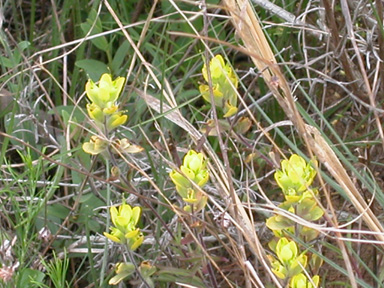
Castilleja kraliana,
an endemic Indian Paintbrush.
After
exploring this area for a while, we again headed through the forest in a northwestern
direction. The forest here was sooty from recent burns and terrain was very
steep in places making walking less than easy and treacherous at times. We
were searching for a particular glade that looked to be the most extensive
one on the map, but decided it might be easier to go back to the truck and
drive there. So, we did just that-headed back to the truck and drove north
on County Road 65 maybe a mile before turning left on Fullman Lane. After
driving down Fullman Lane for another mile or so we arrived at what appeared
to be the most likely entrance to the glade we were searching for. We walked
in through a strip of burned woods and there it was. This was definitely the
most extensive glade we had see thus far and we called this site "Glade
4". There was plenty of the Onosmodium and Castilleja blooming here as
well as other plants that we were less than sure about. After some collecting
and exploring, we headed to Centerville to get some food before our night-time
collecting excursions began.
After supper, we collected for
a while a site on County Road 65 just past the gravel pit at a power line
cut. We were looking for a glade supposedly in this area, but did not find
it. However, I collected some Camponotus and Formica on young pine trees (loblolly)
that were tending aphids. These two species of ants were never found together
on the same tree, but always on different trees. Also collected on these young
pines were a black elaterid, a buprestid, and Typocerus zebra (cerambycid).
Our next stop was to put out a
box trap with black light at Glade 1. We set the trap up on a ledge high above
the river and put a rain guard over it as well and tied it to three trees
to keep it steady. At the time we put this trap up the weather was still quite
nice, but by the time we got back to the truck, we began hearing thunder,
and were a little apprehensive about the ensuing collecting.
We then drove over to Glade 4 and
put up three sheets and lights. It was challenging finding trees to tie sheets
to, but eventually we found some, mostly at the edges of the glades. Right
after we got the last sheet staked down a serious looking storm moved in and
our sheets were billowing like the sails of a ship and there was thunder and
lightning in the air. We didn't really think we would be collecting much,
but we hung around just in case. Fortunately, the storm passed by us and it
ended up being a pretty good night to collect, at least for moths. The collecting
started out slow, but gradually picked up until it again slowed down around
11:00 PM. The temperature dropped considerably and we were actually cold.
We took the sheets down and went back to the motel for the night.
The next morning, we went and retrieved
our box trap. It was still intact and had insects in it, so we were relieved.
The rain guard and the ropes (for box trap stability) were covered with fire
ants (Solenopsis invicta) and it took a few minutes to remove the ants. Fortunately, most of the
fire ants had not made it into the box trap itself, and the ones that had
were killed by the cyanide killing agent. Terry and I spent the next couple
of hours sorting the trap in the bed of the pickup truck. The trap had quite
a few moths in it and tons of Trichoptera. The most abundant moth was a species
of aquatic pyralid that was also seen in great numbers on the vegetation at
the edge of the river.
After we finished the box trap
sorting, we followed the nature trail that started near the parking area.
The trail meandered through the forest and through four small glades. The
first three glades were so close to one another that we used the same latitude
and longitude readings for collections made at any one of the three. We referred
to these sites collectively as "Glade 5". I got a Berlese litter
sample at the first of these glades from some litter at the bases of a cluster
of trees in the center of the glade. I also collected a scorpion under a rock.
The third glade in this group of three glades was on a very steep slope and
the vegetation here was slightly different. This was the only place we saw
Verbena simplex growing and Terry collected some insects on a flowering bush,
perhaps in the family Styracacea while I collected some ants.
We continued down the trail in
the woods for quite some time before finally arriving at a very small glade
just past a small creek. We called this glade, "Glade 6" and stayed
in that area to collect for a while. The collections I made were primarily
in the woods very near the glade and under or in a rotting tree. I took a
Berlese sample from the litter and soil beneath the rotting tree and collected
a nest of Pheidole dentata in the tree itself.
Eventually, we worked our way back
to the parking area and then ventured back to Glade 4, on Fullman Lane. While
at Glade 4, I took some photos and we collected some day-flying insects. Sometime
in the mid afternoon, we headed back to Starkville and took care of what specimens
we had collected.
Part 2. The second phase of the
Cross trip was held from 4-6 June, 2003. Participants included Richard
Brown (MEM director), Terry
Schiefer, Beverly Smith
(graduate student, MEM), JoVonn
Hill (MEM grad. student), Sang
Mi Lee (MEM grad. student), Joe
MacGown, and James C. Trager who served as expedition leader. James works
as a botanist/biologist for the
Shaw Nature Reserve in Missouri and also is a well known myrmecologist.
His knowledge of both ants and plants greatly enhanced our expedition experience.
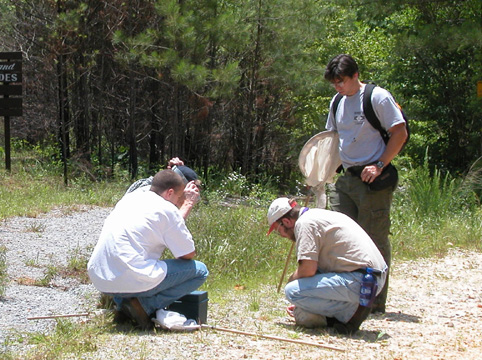
From left to right: JoVonn Hill, James Trager,and Joe MacGown
(Richard Brown mostly hidden from view behind JoVonn)
We arrived in Bibb County just
before noon on June 4th and checked into our motel in Brent. After eating
lunch at Subway, we headed to the glades, which were about 30 minutes away.
Our first stop was Glade 1 where
we all collected. While there Terry and I put out 1 malaise trap, 1 Lindgren
funnel trap, and 1 barrier trap. Traps were placed up on a hill near the forest
edge. There were some different plants in bloom this month than were seen
on our earlier trip in May. An interesting looking sunflower-like composite,
Tetragonatheca helianthioides, was blooming and I collected some ants on flowers
of it. Leptopus phyllantoides (Euphorbiaceae), Rhynchosia tomentosa (Fabaceae,
a small yellow flowered legume), a beautiful Hypericum and many other flowers
were blooming.
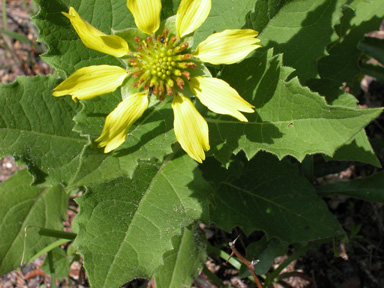
Tetragonatheca helianthioides
James, JoVonn, and I primarily
collected ants on this trip, although other insects were collected as well.
JoVonn collected all grasshoppers he saw. James picked up some Psuedomyrmex
pallidus in the culms of Andropogon gerardii (big blue stem). We also picked
up some litter samples from the woods bordering the small glades. Beverly
concentrated her collecting efforts on wild bees, while Richard, Sang Mi,
and Terry collected various other insects.
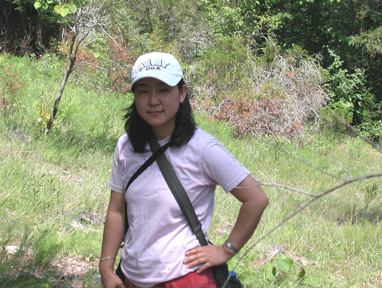
Sang Mi Lee, at Glade 1 near the Little Cahaba River
Later in the afternoon we all went
to Glade 4 on Fullman Lane, where, again, everyone explored and collected.
Terry and I put out a malaise trap, a barrier trap, a Lindgren funnel trap,
and 5 pitfall traps. Although, the glade here was larger than the other small
glades, it seemed to have much less diversity of insects. The imported fire ant,
Solenopsis invicta, had really taken over this area, and was one of the few
ant species seen here.
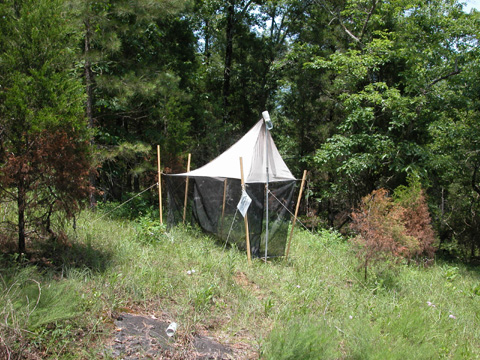
Malaise trap on hill at Glade 1
After collecting and putting out
traps at Glade 4, we went back to Brent to eat supper. Several of us opted
for a local restaraunt, while James and JoVonn ate later as they weren't hungry
yet.
After dinner most of us headed
back to the glades to blacklight with exception of James and JoVonn, who stayed
at the motel to go through litter samples collected that day. We put three
sheets and blacklights up at Glade 1. Additionally, Terry and Richard put
up a small box trap with ethyl accentuate used as a killing agent at Glade
3. Richard and I put out a larger box trap with cyanide "A" dust
at Glade 4. Unfortunately, the box trap at Glade 4 proved to be a bust because
the cyanide was apparently no longer strong enough to kill the insects. Consequently,
few insects were collected from that trap.
Collecting at the sheets that night
was less than exciting. There were enough moths flying in to keep Richard,
Sang Mi, and me busy, but the other insects were not so plentiful. Even so,
Terry and Beverly collected what was there. Temperatures dipped fairly early
that night and the influx of newly arriving insects dropped off dramatically,
so we decided to call it a night sometime between 11:15 and 11:30 PM.
We took down the sheets and went
back to the motel to put up our catch. Some of the rooms had mini refrigerators
where we could store our insects. Moths were placed in moist relaxing chambers
until they could be spread the following day.
Early the next morning, 5 June,
Richard went to the glades and picked up the boxtraps. He came back to the
motel about 9:00. Upon his arrival the rest of us, except Sang Mi headed out
to collect at Glade 1. Both Sang Mi and Richard stayed at the motel to sort
the box traps and spread moths. Before we left, James collected some ants
by the motel, including Paratrechina bourbonica in the parking lot.
We collected for the rest of the
day at Glades 1, 2, 3, & 5 and the woods adjacent to these glades. Terry
collected on oak-leaved Hydrangea flowers and other flowers along the roadside
coming into Glade 1. Terry also beat trees and shrubs in an effort to collect
cerambycids and other beetles. JoVonn, James, and I geared our collecting
towards ants, but collected other insects when those of interest were seen.
I collected with James and JoVonn a while, trying to learn what I could about
anting from James. Eventually, I broke off from the group and collected on
my own. All three of us collected several litter samples. We sifted through
some of the litter samples in the field and pulled out ants and beetles. Other
litter samples were stored in ziploc bags and taken back to our museum to
run in Berlese funnels. I collected some interesting ants nesting in the sand
beside the Little Cahaba Creek. Two of these ants were Solenopsis pergandei and Paratrechina arenivaga. Beverly concentrated her collecting efforts on
catching bees on flowers, especially in Glade 3.
As the day wore on, we decided
to head back to town and eat some grub. We went back to the motel and grabbed
the Brown guy and the Sang Mi chic and ate supper at the Saw Meal restaraunt.
After supper, Terry, Beverly, Sang
Mi, Richard, and I went to Glade 4 to blacklight. We put up 3 sheets there.
While we blacklighted James and JoVonn sorted litter samples at the motel.
Again, collecting was less interesting than hoped for. We did get a variety
of insects nonetheless. At some point near 11:00, we wrapped up the blacklighting
and headed back to the motel.
The next morning, 6 June, we loaded
up the trucks and went back to the museum. After arriving at the museum, we
unloaded everything and got Berlese funnels going. JoVonn and I continued
to bug James about all things ant related until he was ready to pass out from
exhaustion. We finally relented and I think he went and found a bed to crash
in.
Part 3. The third trip to the Bibb
County Glades was on 6 and 7 August 2003. Richard Brown, Terry Schiefer, Jim
Goode, and I (Joe MacGown) participated in this particular journey. Jim Goode,
at the time of this trip, was a new graduate student in Entomology looking
forward to studying Scolytidae in Mississippi.
We arrived in Brent, Alabama at
about 11:00 A.M. and were welcomed by rain. The day was looking quite bleak
and very wet, not the best conditions for most types of collecting. Anyway,
we checked into our motel, the famous Windwood Inn, where we met Barry Hart
of the Alabama Natural Heritage Program. We all moseyed over to Subway and
ate some sandwiches while it continued to rain. Everybody headed back to the
motel where we waited (hoped, prayed...) for the rain to end, or at least
slacken a bit. Early in the afternoon, it did finally slow down somewhat and
we chanced a trip to the glades, since that was why we drove over and all.
We first went to Glades 1, 2, and
3 to collect. The area was very wet, but at least the rain had stopped. Sweeping
of vegetation was impractical, due to the degree of wetness present, however
other collections were made. I managed to collect four litter samples even
though the ground was saturated. Two of the samples came from the soil in
the hollow at the base of an old sycamore tree located just beside the Little
Cahaba River at Glade 1. The hollow area was covered by a thin layer of the
tree, which I removed in order to get to the soil and litter. The soil was
actually fairly dry, consequently, and I found several good things, including
at least one new record of ant for Alabama. A large larva of Dynastes
tityas, the unicorn beetle (in the family Scarabaeidae) was found here
as well. The other two soil and litter samples were also obtained from the
Glade 1 area, but in the woods adjacent to the Glade itself. Both of the two
samples were found in a hollow stump in the woods.
I made collections of Bombis (bumble
bees) on flowers at Glade 1 and collected a colony of Pseudomyrmex pallidus (cool elongate and somewhat elangant ant) in stems of big bluestem grass. I collected some Halictus sp. bees on Rudbeckia at Glade 2 and made other collections of anything seen.
Richard collected quite a bit in
Glades 1, 2, and 3. He found some very nice little mirids (plant bugs) on
the new species of Silphium at Glade 2. He also collected other insects, including
blister beetles (Meloidae), ants, etc. At Glade 3 he collected colonies of
Dorymymex bureni, a fast moving little Dolichoderine ant.
Terry concentrated his collecting
on the various day flying groups such as bees, wasps, flies, and also beetles.
His collections were mostly made on specific flowers. Jim occupied his time
making collections of various insects including bees, grasshoppers, etc. The
was the first collecting trip Jim had been on with us, so he also observed
how we collected the various insects, with everybody pointing out interesting
things when seen.
All in all, even though the day
started out wet, we had success with our afternoon collecting and the sun
was finally out in full force by late afternoon. However, it was soon time
to eat some supper, so we headed into town for a little grub.
After dinner, we went to Glade
4 and put up 3 sheets with blacklights. Richard put up a large blacklight/box
trap with cyanide dust in it at Glade 3 and a smaller box trap with Ethyl
Acetate at Glade 1 up on the hill overlooking the river.
All four of us collected at the
sheets at Glade 4. The night collecting was in general, pretty slow, possibly
due to the high humidity. I collected a variety of things, even so, mostly
moths and small beetles. Richard collected mostly moths, Terry collected beetles,
and other non-moths, and Jim collected everything except for moths. After
pulling down the sheets, just after 11:00, we went back to the motel, took
care of our specimens and called it a day.
The next morning, 7 August 2003,
Richard and I went to Glades 1 and 3 to retrieve the box traps. The smaller
trap at Glade 1 had fire ants crawling on it, but none (or very few) got into
the trap itself. We took what we had and went back to the motel and loaded
the rest of the equipment into the truck in the, yes, you guessed it, rain.
Richard sorted the box traps on the drive back to MSU. Quite a feat actually,
but he managed nonetheless.
LOCALITY DATA AND HABITAT INFO
Bibb County Glades Preserve
Glade 1, near entrance to Preserve by Little Cahaba Rvr.
included 3 small glades
ALA.,Bibb Co.
Bibb Co. Glades Pres.
33°03'26'N87°02'02"W
Glade 2, very near Site 1, but on side ride going thru private
property-lots of Senecio (in May)
ALA.,Bibb Co.
Bibb Co. Glades Pres.
33°03'34'N87°02'06"W
Glade 3-Glade near 1 & 2, but on the other side of
private property area
ALA.,Bibb Co.
Bibb Co. Glades Pres.
33°03'35'N87°02'12"W
Glade 4-on Fullman Lane, most extensive glade
ALA.,Bibb Co.
Bibb Co. Glades Pres.
33°03'28'N87°02'21"W
Glade 5-glade after first creek from Glade 1, thru woods
on trail-unburned
ALA.,Bibb Co.
Bibb Co. Glades Pres.
33°03'27'N87°01'54"W
Glade 6-very small glade yet farther down trail thru woods
from glades 1 & 2
ALA.,Bibb Co.
Bibb Co. Glades Pres.
33°03'31'N87°01'55"W
Other sites (non Glade sites)
Brent, Windwood Inn
ALA.,Bibb Co.
Brent
32°56'41"N 87°09'26"W
County road 65 site, powerline cut
ALA.,Bibb Co.
Co. Rd. 65
33°03'32"N87°01'43"W
Habitats
Dolomite Glades
Mixed Forest near
Dolomite Glades


